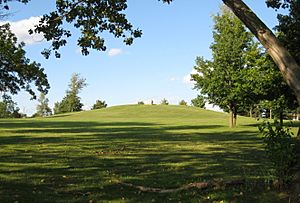Taber Hill facts for kids

Taber Hill
|
|
| Details | |
|---|---|
| Established | Post Woodland period |
| Location | |
| Country | Canada |
| Type | Wyandot (Huron) burial mound (ossuary) |
| Style | burial mound |
| No. of graves | 523 |
Taber Hill, also known as Tabor Hill, is a special ancient burial site in Toronto, Ontario. It's a burial mound (a hill made for burying people) that belongs to the Wyandot (Huron) First Nation. This important place is found in the Scarborough area of Toronto.
Scientists believe Taber Hill was created in the 14th century, which is over 600 years ago! It holds the remains of more than 500 Huron/Wendat people. This site is very unique because it's thought to be the only First Nations ossuary (a place where bones are kept) in Canada that is officially protected as a cemetery.
Contents
What is Taber Hill?
Taber Hill is a mound-shaped area that covers about 0.34 hectares (less than one acre). The main burial spot, called an ossuary, was found to be about 15 meters long, 2 meters wide, and 0.3 meters deep.
When it was first studied, experts thought about 472 people were buried there. Later, they realized the site belonged to the Wyandot (Huron) people, who are related to the Six Nations. The total number of buried people was updated to 523.
How People Were Buried
The skeletons at Taber Hill were buried in a special way. This method matches a traditional ceremony called the Wendat Feast of Souls. This ceremony was a very important ritual for the Huron/Wendat people.
Nearby Ancient Villages
In the same year Taber Hill was found, an ancient Iroquoian village was discovered nearby. This village was located west of the burial mound. Experts believe these two sites might be connected.
Another, even larger, Huron/Wendat village was found in 2000. This village, called the "Alexandra Site," was home to an estimated 800 to 1000 people. Archaeologists think it's possible that all three sites are linked together. Other Iroquoian sites also exist in the Rouge River valley, showing that this area was once home to many First Nations communities.
How Taber Hill Was Discovered
The Taber Hill cemetery was found by accident on August 17, 1956. Workers were using a large machine called a steam shovel to remove a 18-meter-high hill. The soil was needed to build a highway overpass for Highway 401. The land was then going to be used for new houses.
After digging about 30 meters into the hill, the workers found many human bones. All work stopped right away so experts could investigate. At first, some thought the bones were not from Indigenous people. They believed it might have been a mass burial from a sickness in the 1870s.
Archaeological Investigation
Walter Kenyon, an assistant curator from the Royal Ontario Museum, led the archaeological study of the site. His team found a second burial pit. Kenyon described the larger pit as the "deepest ossuary" he had ever seen. He called it "the most significant ethnological discovery in Canada's history."
Protecting the Site
Just five days after the discovery, on August 22, 1956, Taber Hill was declared a historical site. This was done by Bryan Cathcart, an Ontario government minister. The site was then guarded by police to prevent any items from being taken. The Government of Ontario bought the land, trading it for other land nearby.
Reburial Ceremony
Representatives from the Iroquois Six Nations were invited to help with a special reburial ceremony. This ceremony was based on the Iroquois Feast of the Dead. It took place over three days, from October 19 to 21. Chief Joseph Logan oversaw the event. More than 200 Indigenous people and thousands of others attended.
A new, deep hole was dug for the bones. The bones were carefully reburied, with wolf pelts placed on top. After the ceremony, a dinner was held. Iroquois representatives continued to hold Feast of the Dead ceremonies at the site every year from 1957 to 1966.
Taber Hill Today
In 1961, a memorial was placed at the top of the mound. One side has a historical plaque from Scarborough Township. The other side has a plaque with a prayer. This prayer is actually from the Lakota Nation, not the Iroquois, but it was approved by an Iroquois Council.
Today, Taber Hill is officially a cemetery and is managed by the City of Toronto government. The area around it is known as Tabor Hill Park. Even though it's a cemetery, people sometimes use the area like a regular park. For example, Tobogganing is a popular activity on the steep hill during winter.

